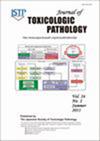胆管上皮CD44表达与胆碱缺乏、蛋氨酸降低、l -氨基酸饮食诱导的非酒精性脂肪性肝炎大鼠肝纤维化有关
IF 0.9
4区 医学
Q4 PATHOLOGY
引用次数: 3
摘要
非酒精性脂肪性肝炎是一种与生活方式相关的疾病,在世界范围内威胁日益严重。肝纤维化是由慢性肝病(包括非酒精性脂肪性肝炎)引起的,与肝脏病变(如脂肪变性和炎症)的死亡率密切相关。因此,确定可以作为肝纤维化诊断和治疗靶点的因素是很重要的。在这项研究中,我们检测了CD44在胆碱缺乏、蛋氨酸降低、l -氨基酸饮食喂养的大鼠肝纤维化发展中的功能,特别是在胆管上皮增殖方面。雄性Fischer 344大鼠被喂食缺乏胆碱、降低蛋氨酸、l -氨基酸的饮食2周、4周、13周或26周。这种饮食减少了体重;血清谷草氨酸、丙氨酸转氨酶等肝损伤指标升高;肝脏中炎症和纤维化相关基因表达上调;并导致肝脏病变的发展,包括肝细胞脂肪改变,炎症细胞浸润和纤维化。肝透明质酸被合成并沉积在肝组织中。在整个实验期间,CD44 mRNA和蛋白的表达均显著升高。部分胆管上皮可见CD44蛋白,周围可见透明质酸沉积,胆管病变与肝纤维化区一致。因此,在胆管上皮中表达的CD44可能是控制非酒精性脂肪性肝炎相关肝纤维化的靶点。本文章由计算机程序翻译,如有差异,请以英文原文为准。
CD44 expression in the bile duct epithelium is related to hepatic fibrosis in nonalcoholic steatohepatitis rats induced by a choline-deficient, methionine-lowered, L-amino acid diet
Nonalcoholic steatohepatitis is a lifestyle-related disease and an increasing threat worldwide. Hepatic fibrosis, which results from chronic hepatic diseases including nonalcoholic steatohepatitis, is closely correlated with mortality among hepatic lesions, such as steatosis and inflammation. Thus, it is important to identify factors that can serve as diagnostic and therapeutic targets for hepatic fibrosis. In this study, we examined the function of CD44 in the development of hepatic fibrosis in choline-deficient, methionine-lowered, L-amino-acid diet-fed rats, especially with respect to the proliferation of bile duct epithelium. Male Fischer 344 rats were fed a choline-deficient, methionine-lowered, L-amino-acid diet for 2, 4, 13, or 26 weeks. This diet decreased the body weight; increased the levels of serum parameters indicating liver injury, such as aspartate and alanine aminotransferase; upregulated inflammation- and fibrosis-related gene expression in the liver; and resulted in the development of hepatic lesions, including fatty changes in hepatocytes, inflammatory cell infiltration, and fibrosis. Hepatic hyaluronan was synthesized and deposited in the liver tissue. The expression of both CD44 mRNA and protein was significantly increased throughout the experimental period. CD44 protein was observed in some of the bile duct epithelium, around which hyaluronic acid was deposited, and these bile duct lesions were concordant with the area of hepatic fibrosis. Thus, CD44 expressed in the bile duct epithelium may be a target for controlling nonalcoholic steatohepatitis-related hepatic fibrosis.
求助全文
通过发布文献求助,成功后即可免费获取论文全文。
去求助
来源期刊

Journal of Toxicologic Pathology
PATHOLOGY-TOXICOLOGY
CiteScore
2.10
自引率
16.70%
发文量
22
审稿时长
>12 weeks
期刊介绍:
JTP is a scientific journal that publishes original studies in the field of toxicological pathology and in a wide variety of other related fields. The main scope of the journal is listed below.
Administrative Opinions of Policymakers and Regulatory Agencies
Adverse Events
Carcinogenesis
Data of A Predominantly Negative Nature
Drug-Induced Hematologic Toxicity
Embryological Pathology
High Throughput Pathology
Historical Data of Experimental Animals
Immunohistochemical Analysis
Molecular Pathology
Nomenclature of Lesions
Non-mammal Toxicity Study
Result or Lesion Induced by Chemicals of Which Names Hidden on Account of the Authors
Technology and Methodology Related to Toxicological Pathology
Tumor Pathology; Neoplasia and Hyperplasia
Ultrastructural Analysis
Use of Animal Models.
 求助内容:
求助内容: 应助结果提醒方式:
应助结果提醒方式:


